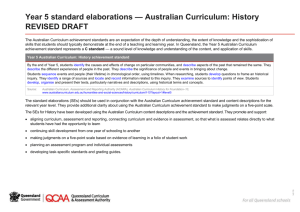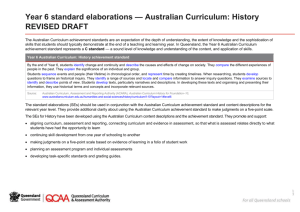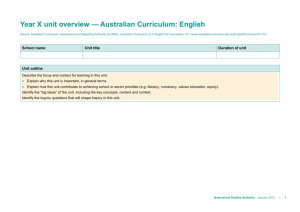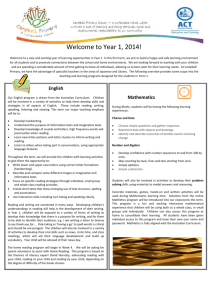Year 3 History standard elaborations (DOCX, 109 kB )
advertisement
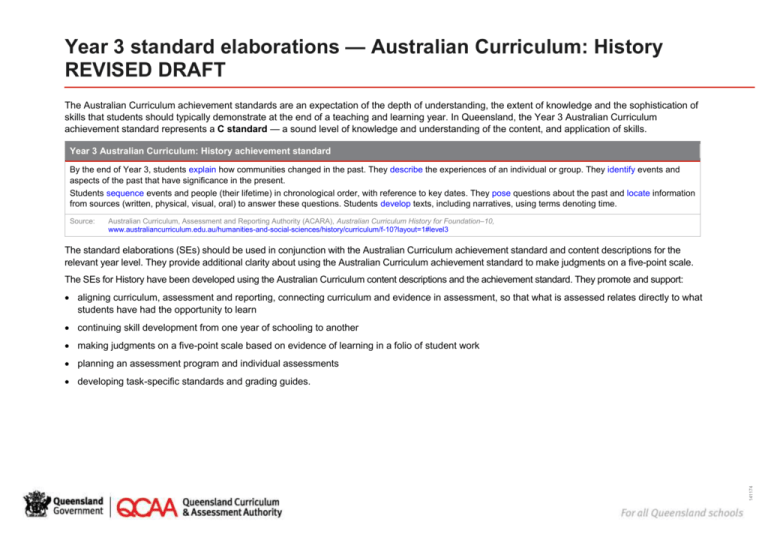
Year 3 standard elaborations — Australian Curriculum: History REVISED DRAFT The Australian Curriculum achievement standards are an expectation of the depth of understanding, the extent of knowledge and the sophistication of skills that students should typically demonstrate at the end of a teaching and learning year. In Queensland, the Year 3 Australian Curriculum achievement standard represents a C standard — a sound level of knowledge and understanding of the content, and application of skills. Year 3 Australian Curriculum: History achievement standard By the end of Year 3, students explain how communities changed in the past. They describe the experiences of an individual or group. They identify events and aspects of the past that have significance in the present. Students sequence events and people (their lifetime) in chronological order, with reference to key dates. They pose questions about the past and locate information from sources (written, physical, visual, oral) to answer these questions. Students develop texts, including narratives, using terms denoting time. Source: Australian Curriculum, Assessment and Reporting Authority (ACARA), Australian Curriculum History for Foundation–10, www.australiancurriculum.edu.au/humanities-and-social-sciences/history/curriculum/f-10?layout=1#level3 The standard elaborations (SEs) should be used in conjunction with the Australian Curriculum achievement standard and content descriptions for the relevant year level. They provide additional clarity about using the Australian Curriculum achievement standard to make judgments on a five-point scale. The SEs for History have been developed using the Australian Curriculum content descriptions and the achievement standard. They promote and support: aligning curriculum, assessment and reporting, connecting curriculum and evidence in assessment, so that what is assessed relates directly to what students have had the opportunity to learn continuing skill development from one year of schooling to another making judgments on a five-point scale based on evidence of learning in a folio of student work planning an assessment program and individual assessments 141174 developing task-specific standards and grading guides. Year 3 History standard elaborations A REVISED DRAFT B C D E Historical knowledge and understanding Questioning and researching Analysing and interpreting Understanding and skills dimensions The folio of student work has the following characteristics: comprehensive explanation of how communities changed in the past detailed explanation of how communities changed in the past explanation of how communities changed in the past description of changes in communities in the past statements about changes in communities in the past comprehensive description of the experiences of an individual or group detailed description of the experiences of an individual or group description of the experiences of an individual or group description of aspects of the experiences of an individual or group statements about the experience of an individual or group identification and explanation of events and aspects of the past that have significance in the present identification and description of events and aspects of the past that have significance in the present identification of events and aspects of the past that have significance in the present identification of aspects of events and aspects of the past statements about events and aspects of the present posing of questions about the past and location and considered use of information from sources (written, physical, visual, oral) to effectively answer these questions posing of questions about the past and location and informed use of information from sources (written, physical, visual, oral) to effectively answer these questions posing of questions about the past and location and use of information from sources (written, physical, visual, oral) to answer these questions posing of questions about the past and location and use of information from sources to answer aspects of these questions use of questions about the past and location of information comparison of objects from the past to present to draw reasoned conclusions about change comparison of objects from the past and present to draw conclusions about change comparison of objects from the past and present description of objects from the past and present statements about objects from the past and present Year 3 standard elaborations — Australian Curriculum: History REVISED DRAFT Queensland Curriculum & Assessment Authority February 2015 Page 2 of 5 A B C D E Key Communicating Understanding and skills dimensions The folio of student work has the following characteristics: accurate and detailed sequencing of events and people’s lifetimes in chronological order with reference to relevant key dates detailed sequencing of events and people’s lifetimes in chronological order with reference to relevant key dates sequencing of events and people’s lifetimes in chronological order with reference to key dates partial sequencing of events and people’s lifetimes in chronological order with reference to dates listing of events and people’s lifetimes development of texts, including narratives, with considered use of relevant terms that denote time. development of texts, including narratives, using relevant terms that denote time. development of texts, including narratives, using terms that denote time. development of texts, including narratives, using everyday language. development of aspects of texts, including narratives, using everyday language. Shading emphasises the key aspects of the achievement standard and qualities that discriminate between the A–E descriptors. Key terms are described overleaf. Year 3 standard elaborations — Australian Curriculum: History REVISED DRAFT Queensland Curriculum & Assessment Authority February 2015 Page 3 of 5 Notes Australian Curriculum common dimensions The SEs describe the qualities of achievement in the two dimensions common to all Australian Curriculum learning area achievement standards — understanding and skills. Dimension Description understanding the concepts underpinning and connecting knowledge in a learning area, related to a student’s ability to appropriately select and apply knowledge to solve problems in that learning area skills the specific techniques, strategies and processes in a learning area Terms used in Year 3 History SEs The following terms are used in the Year 3 History SEs. They help to clarify the descriptors, and should be read in conjunction with ACARA’s History glossary: www.australiancurriculum.edu.au/humanities-and-social-sciences/history/Glossary. Term Description accurate consistent with a standard, rule, convention or known facts; in Year 3 History, includes sequencing events in correct order aspects particular parts or features comparison; compare estimate, measure or note how things are similar or dissimilar considered thought about deliberately with a purpose description; describe give an account of characteristics or features detailed meticulous; including many of the parts development; develop elaborate or expand in detail draw conclusions make deductions or inferences from information effectively meeting the assigned purpose in a way that produces a desired or intended result explanation; explain provide additional information that demonstrates understanding of reasoning and/or application identification; identify establish or indicate who or what someone or something is; includes recognition informed having relevant knowledge; being conversant with the topic information knowledge communicated or received concerning some fact or circumstance list; listing a record consisting of a series of names, words, or the like; a number of names of persons or things set down one after another location; locate act or process of finding or obtaining, usually in reference to research or working with information sources Year 3 standard elaborations — Australian Curriculum: History REVISED DRAFT Queensland Curriculum & Assessment Authority February 2015 Page 4 of 5 Term Description narrative a text that makes sense of the past based on a selection of a sequence of events; a text that compares the past with the present to determine change; narrative texts include stories and recounts partial attempted; incomplete evidence provided relevant having some logical connection with sequence; sequencing arrange in a definite order; in History, sequencing includes chronological order significance importance, of consequence; in History, the importance assigned to particular aspects of the past, (e.g. events, developments, movements, historical sites) source any written or non-written materials that can be used to examine the past; in Year 3 History, sources could include letters, diaries, radio and television programs, objects terms that denote time terms giving detail about the passing of time; in Year 3 History, terms related to time include: then, now, old, new, yesterday, today, tomorrow, before, after, past, present, future, the olden days, years ago, a long time ago text; texts the means for communication; their forms and conventions have developed to help us communicate effectively with a variety of audiences for a range of purposes; texts can be written, spoken or multimodal and in print or digital/online forms; multimodal texts combine language with other systems for communication, such as print text, visual images, soundtrack and spoken word as in film or computer presentation media use of to operate or put into effect Year 3 standard elaborations — Australian Curriculum: History REVISED DRAFT Queensland Curriculum & Assessment Authority February 2015 Page 5 of 5

